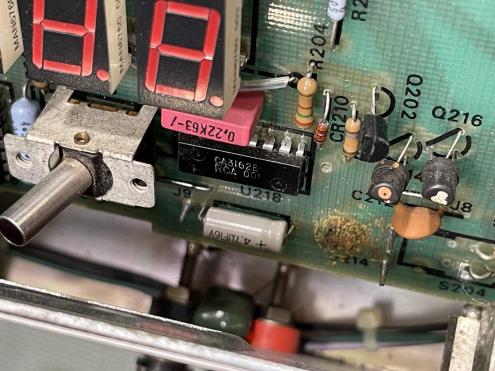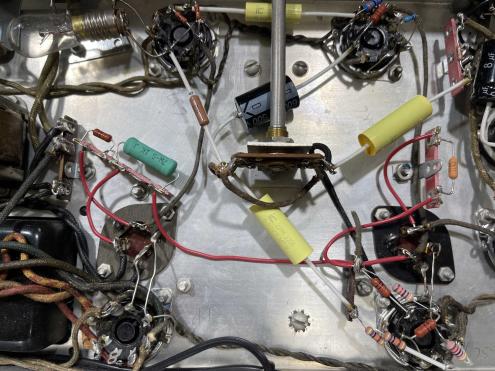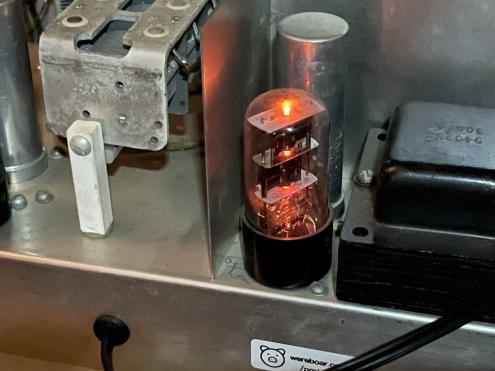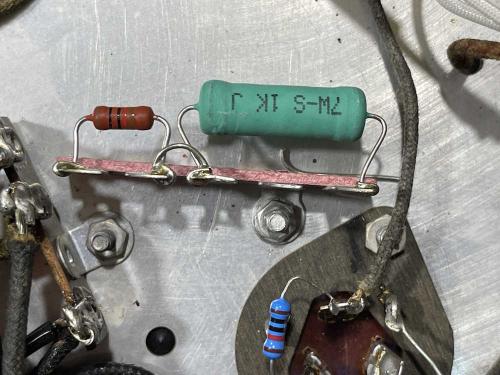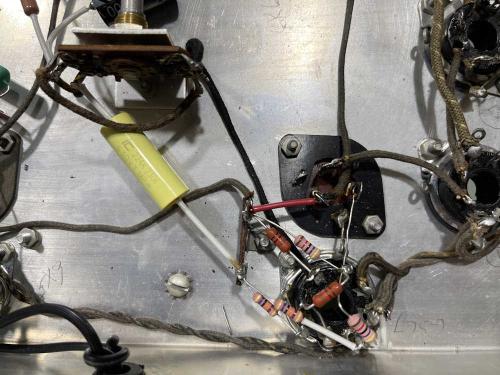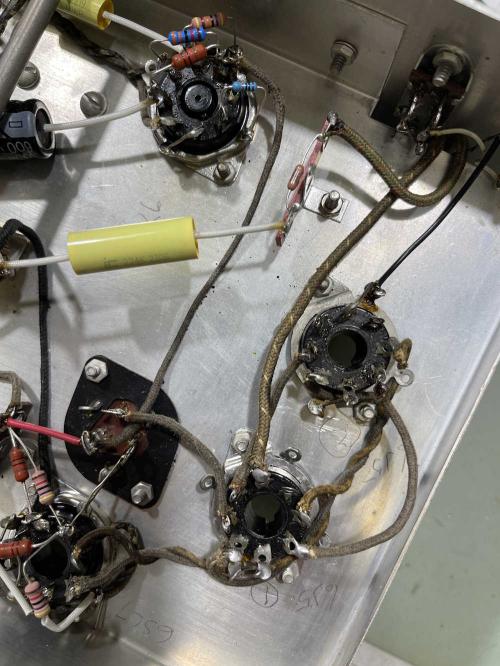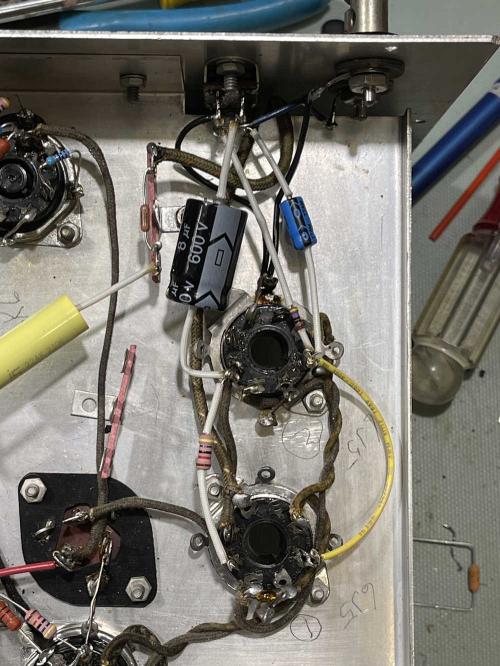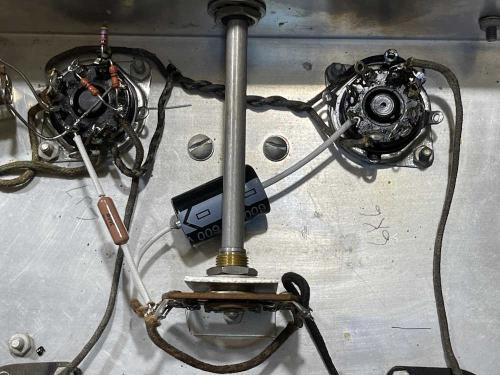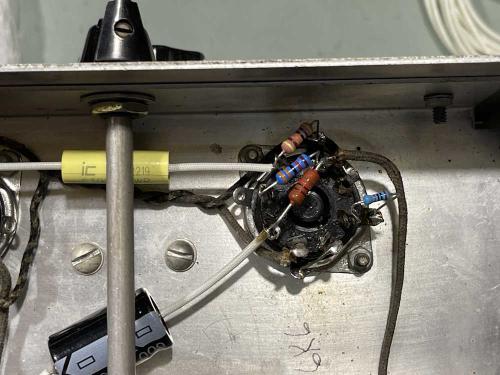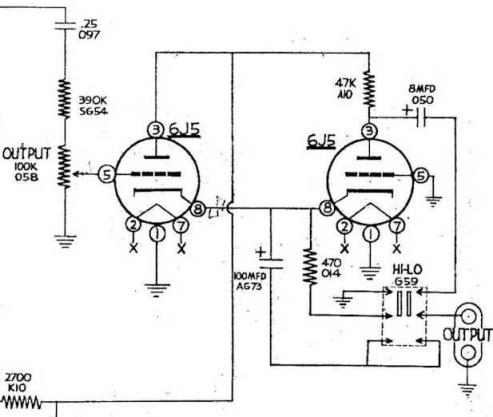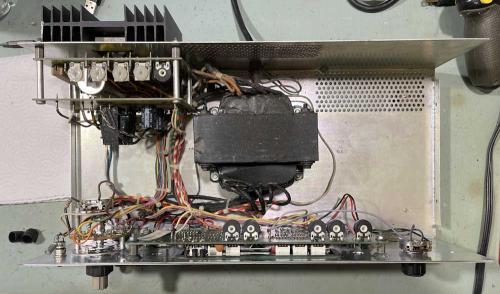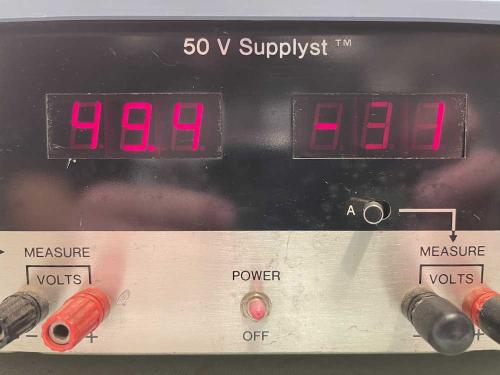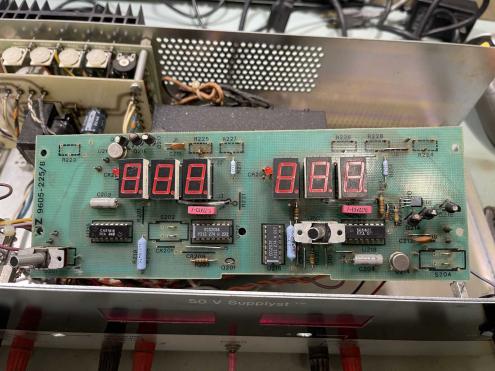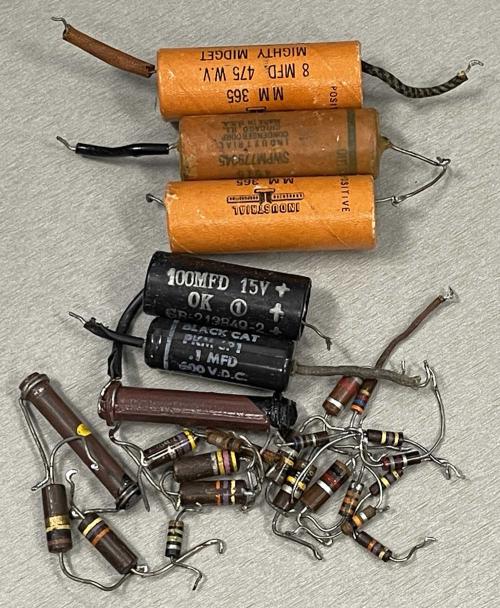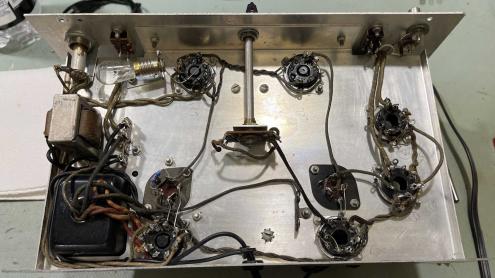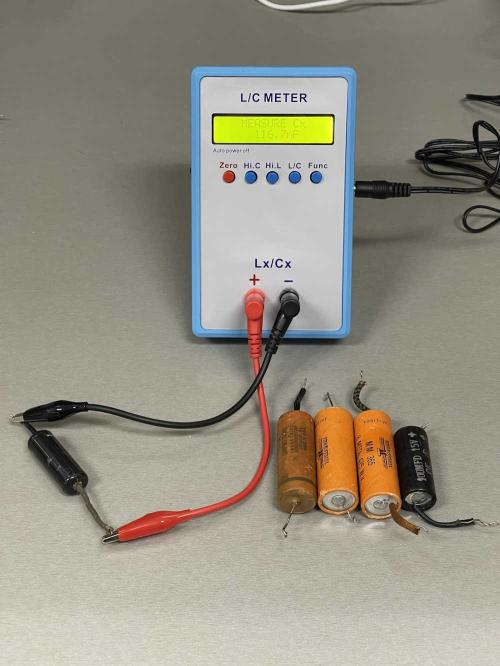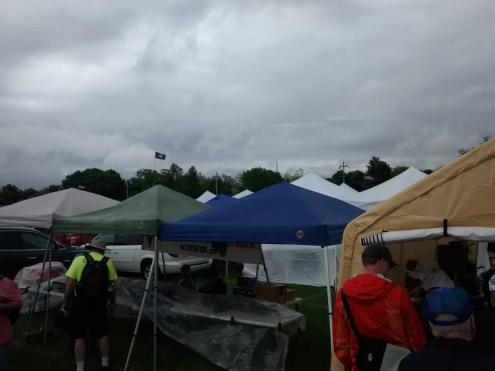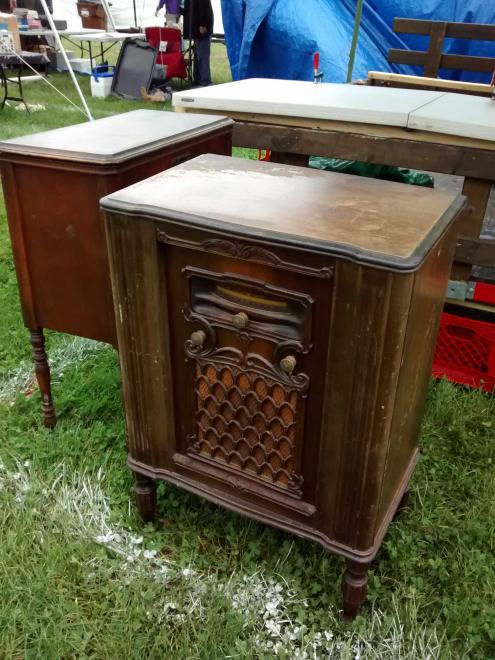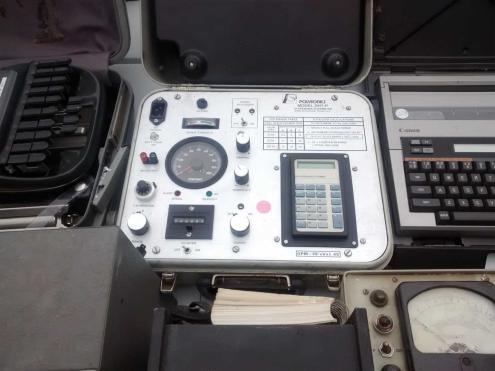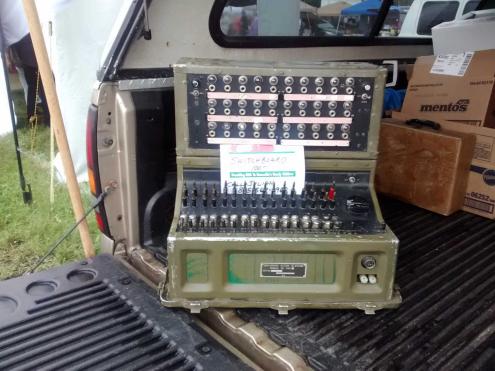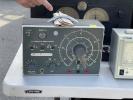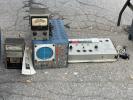- 2025
- Oct
- 13
A Viz WP-705 Power Supply part 2: Musings on faults
When I opened this Viz WP-705, it seemed to be a fairly clear cut case of the A/D failing. But, after some more tracing circuits, there are a couple of other things here.
Each side of this device’s displays are driven by their own regulator, so each side has a LM309H LDO 5V device in a TO-5 package. So, that could also be a problem. I decided to wait until I received the manual I ordered for it.
The manual arrived eventually after being scanned delivered on one day and showing up the next. Unfortunately, it wasn’t as useful as I’d hoped, and I’m not sure why it is like it is. The manual copy is dated 1978, and my power supply is dated 1980. Since RCA was obviously no longer slapping their name on the units, you’d think that, eventually, all of the RCA parts would be removed in favor of other commercial equivalents. The manual does suggest this, as it’s using different A/D / Driver pairs than what my unit has.
My unit still has RCA parts. I would think a later model would have the non-RCA parts, but I guess not. Perhaps they made these with multiple variants depending on what chips were available? Regardless, other than the power supply portion itself which seems to follow the manual, the actual portion I’m interested in isn’t laid out in the manual I have. Oh well.
Anyway…
I decided to check the 5V lines for both sides, since I now know there are two individual rails. The working side is ~5V. The non working side is down near 2.6VDC, and the input is about 4.6VDC. That’s certainly wrong.
Time to pull it out.
There’s some crusty flux under the device, I’ll clean that off with some alcohol. Now the input reads about 12VDC, which is probably fine as it’s input is unregulated. I decided to pull the small capacitor beside the regulator, it wasn’t shorted but it had an ESR of 28Ω so it’s dry. I’m sure the other one is too. I have a couple of 4.7μF parts laying around, I’ll replace both.
Something is drawing the voltage down, but is it the regulator? I’m not sure - I didn’t feel anything getting hot during testing.
I’m going to go ahead and check all those transistors for shorts, and try to do some comparative measurements with the other side. I also have some LM309H parts laying around somewhere, it’s just a matter of figuring out which bin I put them in. Stay tuned for part 3 and hopfully a full diagnosis.
Next part of this series: Coming soon.
Previous part of this series: https://wereboar.com … ply-part-1-analysis/
- 2025
- Oct
- 13
The Heathkit AG-7 Audio Generator part 8: Finishing up and final checks.
The last thing to do with the Heathkit AG-7 on the bench is make the power supply connections. Since I didn’t want to put any components on the filter capacitor cans, the parts that would have ridden there are now on terminal strips and need to be run to their respective terminations with wire. That just involved some…well…wire.
There’s a little bit of wire sticking out there that I need to remove - it was originally a run that got deleted by the parts being moved. For now, it just hangs in the air. That’s all of the connections, so on to the check.
During checking, I found three errors.
2 of those errors were simply no-solders where I had unsoldered a terminal to remove something and didn’t hit it again later. These were both lugs that had components that were moved, so I just never went back to them.
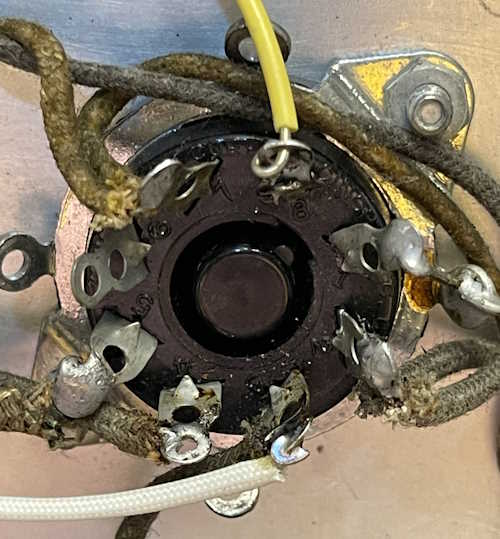
The big error was that I made an assumption. On the Hi/Lo switch, there are a number of connections. The schematic shows this connection as a picture, and I dutifully wired the switch according to the picture. Well…the picture showed certain connections at the top, and with the chassis flipped over I wired it just like that. Turns out the top of the switch is actually…the top when it’s sitting upright when you’d use it during operation. That was an easy fix, a couple of connections and a gold star with derp on it for me.
Nothing else was amiss, the schematic now matched what was in the unit. Time for the smoke test.
No smoke, and I have a signal on the scope!
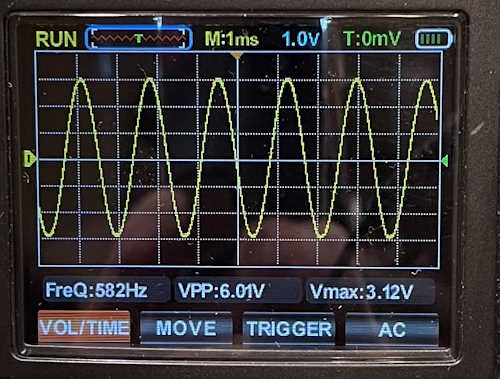
The signal is clean, so the oscillator is driving itself at the proper rate. That’s what I wanted to see!
Next up is final adjustments, final thoughts, and a bit of an interesting find. Stay tuned!
Next part of this series: https://wereboar.com … rt-9-final-thoughts/
Previous part of this series: https://wereboar.com … -part-7-the-rebuild/
- 2025
- Oct
- 9
The Heathkit AG-7 Audio Generator part 7: The Rebuild.
It’s time to start putting parts back in the Heathkit AG-7. I’m generally trying to follow the OEM layout, but I’ve decided to add a few terminal strips for quality of life, and to get parts off the filter capacitors.
The filters are good at this point in time, but eventually they will need to be replaced. Not having anything other than wires on their lugs will make it a lot easier to do this replacement when the time comes. I don’t have any qualms about doing this kind of mod, as I want the device to work. The only reason I’d re-stuff a can of filters is because space is at a premium, which it is in this box. That’s a future post, however!
Here are the rebuild pictures, in no particular order. The only thing left at this point is to remove a couple of mods and to wire some of the filter capacitors back into their new connections.
I hope to have this completed and ready for test by the end of next week. Stay tuned!
Next part of this series: https://wereboar.com … up-and-final-checks/
Previous part of this series: https://wereboar.com … ion-thats-not-right/
- 2025
- Oct
- 9
The Heathkit AG-7 Audio Generator intermission: That’s not right!
Often, when working on an older device, you’ll find part replacements and modifications made by a previous owner to accomplish something. While it’s not always obvious what those modifications were doing, it’s often necessary to remove them in order to restore the device back to OEM functionality.
Case in point is with the Heathkit AG-7 I’m rebuilding. Take these two items:
This is the output adjust potentiometer. Note the 100kΩ resistor.
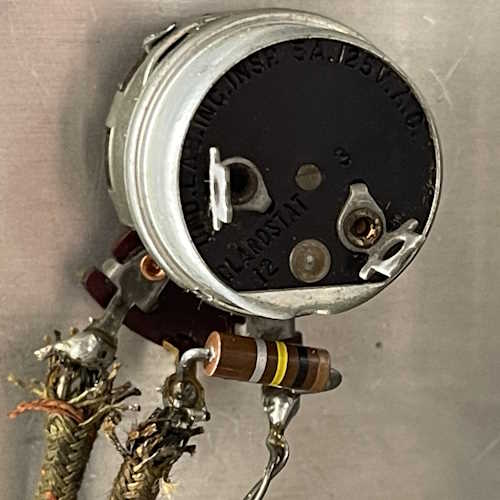
This is the output Hi/Lo switch. See that jumper wire? There’s also that white telephone-style wire that goes from the switch to the output. This would have been cloth coated originally. Not shown is a messy ground connection here, where they simply twisted three pieces of wire together and soldered it in mid-air.
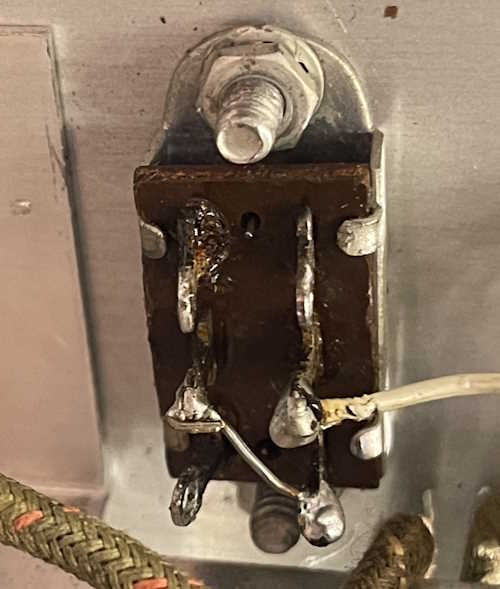
Here’s the schematic for this portion of the device:
You’ll notice the absence of a 100kΩ resistor across the output pot. I have to assume this was to change the linearity of the output for some reason. There’s also a jumper on the switch, but it’s on the bottom and jumpers the lower half together - not catty-corner like the previous owner had. I’m not sure what they were trying to accomplish with that.
These mods come out, and it gets put back to the way it was. Hopefully, this will reduce the amount of smoke that comes out!
Next part of this series: https://wereboar.com … -part-7-the-rebuild/
Previous part of this series: https://wereboar.com … -removing-everthing/
- 2025
- Oct
- 9
You know the stuff you’re working on is old when…
…even your reprint manuals are starting to fall apart. My reprinted copy of the RCA RC-19 tube manual has started to break apart, the glued binding giving way.
This book probably qualifies as an antique itself!
- 2025
- Oct
- 3
A Viz WP-705 Power Supply part 1: Analysis.
On the bench while I wait for parts for the Heathkit AG-7 is this Viz WP-705 power supply. This came from the TUSCO show earlier this year, and while I didn’t need it, the price was cheap. The vendor originally was asking half a bill for it, but when he plugged it in and the ammeter didn’t light up, he reduced it to $10. I took it for that, just because a nice linear supply is always useful.
Viz is the “company” that took over RCA’s test equipment division as it was phased out. RCA contracted out this division to start with, so it was more of a rebadging than anything else. The company that took this over, Jetronic, was already one of their big contract manufacturers, some new paint in the logo area and Viz was born. It still looked just like the RCA device, was full of RCA parts, but had a different name on the front.
Jetronic Industries Inc. appears to have continued until 2000, when they filed for bankruptcy. It was a shell company for some time, before finally being dissolved and removed from records in 2012 for failing to file necessary reports with the SEC. That’s all there is to their story.
Here’s the device in question:
This is a single-output power supply with the ability to use it’s internal meters as external meters - that’s quite unique. It’s part of a series of supplies, with each successive model number adding more features and outputs. This appears to be a middle of the series unit, or bottom of it’s tier depending on where you place it in the model stack. It’s 0-50VDC, 0-2A, and is a linear device built out of discrete components with only the displays having ICs in their circuit.
Inside is a big chonky transformer:
So what’s wrong with this? When I bought it, the ammeter wasn’t working at all. That is, the display was dark. When I put it on the bench, the ammeter lit up, but the display rolled all over the place and didn’t respond to anything. It was like whatever A/D this thing was using was bad and just floating.
What’s on the board?
The unit uses two older RCA chips to do it’s work - the CA3161 and CA3162, which are a driver/converter pair. There’s some glue circuitry as well, which looks like it’s for the display select during driving. As you can see, there’s some different-shape transistors on the board, as well as some ECG parts with a much nicer (i.e. later date) marking, indicating that this device has had some work done to it in the past.
Since there’s not a whole lot here, and the display is still scanning - that kind of points to the CA3162 A/D converter. Unfortunately, with NTE being gone, there are no more new replacements, but NOS devices exist. It’s just a matter of finding one.
I have a schematic on order, I’m going to study that for a bit before proceeding just to make sure I’m not missing anything. Stay tuned!
Next part of this series: https://wereboar.com … 2-musings-on-faults/
- 2025
- Oct
- 3
The Heathkit AG-7 Audio Generator part 6: Removing everthing.
In the last post, I checked a few parts and found that pretty much every resistor (that I could measure in circuit) was out of tolerance, in a bad way. Seeing as how the device stopped oscillating, and started smoking, I decided that replacing everything was the best course of action.
I’m trying to save the old parts for later testing purposes, so unsoldering with intact leads is a must. That does tend to make it’s own problems, something we’ll discuss later on.
Here’s what I recovered (save the 10k removed in a previous step):
The chassis is now empty.
For testing, I just grabbed my scope-meter and a capacitor checker. I’m not really worried about ESR or leakage here, they’re just old and probably have issues with both.
So on to the good stuff. How bad do the parts test? Well, that’s the fun part. Most of them are ok-ish, even the ones that read substantially higher in circuit. The 100k in the previous post? It’s back to well within in tolerance range.
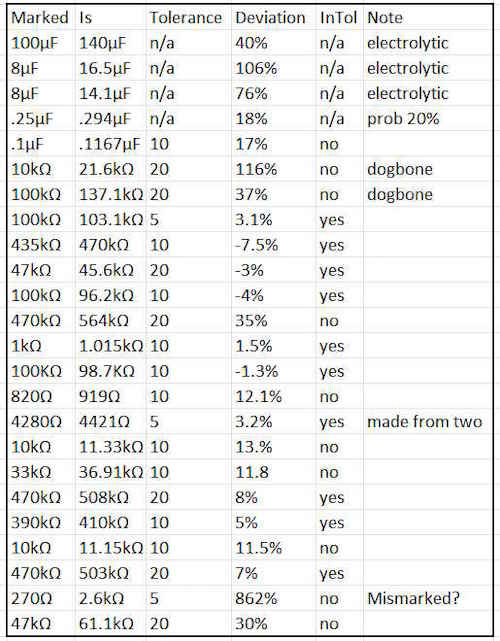
What happened here? Carbon Composite resistors change value over time because the carbon grains disassociate with one another, and they collect moisture. I hit these with some high heat during the desoldering process, which probably drove out the moisture and brought them back near tolerance. I suspect if I left these alone for a year or so, they’d be back to what they were. Perhaps I’ll segregate them and do a follow-up next year.
Of particular note was that 270Ω part that read 2.6kΩ. While this looks brown to me under normal lighting, the camera shows it has more of a red hue. This guy must have been pretty warm over the years and the color simply faded. It’s actually marked 2.7k.
Next up is actually placing new parts. Check back soon!
Next part of this series: https://wereboar.com … ion-thats-not-right/
Previous part of this series: https://wereboar.com … nna-need-everything/
- 2025
- Sep
- 30
Some pictures from the 2018 Dayton Hamvention
I wasn’t really taking a lot of photos at this time, the camera on my phone was an absolute potato and could barely focus in full sun - let alone in overcast conditions like it was on the Friday of the event. However, I did get a few and found them again when searching my photo archives.
This was the third year at the Xenia Expo Center, and it was still pretty packed even though rain threatened all day. The day was very cloudy and vendors opened and closed their booths depending on the whims of Mother Nature.
There were a few vendors there that had nothing but (or mostly) console radios. These vendors have faded away as this old stuff sells and stocks dwindle. There’s simply no more out there like there was 25 years ago.
At the time, I was working for a rather toxic flow meter company. I liked the tech, but not the job. This was taken mostly because of my interest in different kinds of flow measurement equipment - and because it amused me that someone just bolted a calculator on to the face.
Last photo is of an interesting military switchboard. It was just an interesting looking piece.
That’s all…there were a few more but they were blurry to the point of uselessness due to the aforementioned poor quality camera.
See you at Dayton in 2026!
- 2025
- Sep
- 29
Pictures from the 2025 Cleveland Hamfest
This was the second year I attended this show, and it was just as good as last year. While the stuff I like is generally going away (there’s just no more of it,) and some of the same vendors show up everywhere - there was still plenty of good things to see. I managed to make it out of there with only $40 missing from my wallet, so I did good.
Here’s what I saw at the show:
.
Next up is the Early Television Museum fall swap meet in October (no idea on this one, I’ve never been there,) followed by MARC@MAPS and finishing the year with the (disappointing last year) Fort Wayne show.
I’ll probably use this year to make some determinations about which shows I want to attend next year. Some of this years’ shows have been smaller than usual, and seeing the same stuff over and over isn’t interesting. Who knows, but stay tuned for more photos from events and next year’s list. Perhaps it will give me a chance to explore some other, smaller shows that happen on the same dates.
- 2025
- Sep
- 29
Random board shot: A Biamp electronic crossover
Today’s board comes to you from a resale shop. A friend purchased this (used) electronic crossover for his audio stack, and wanted to open it up to give the controls a cleaning and give it a general once-over. Inside was a well laid-out board with plenty of space and a bunch of antique RCA op-amps. The unit works great, and immediately went into the stack.
However, seeing as this was made in the 1980s right here in the USA, we looked for that one particular mark:
Yep, there it is. That orange script “T” indicating the raw board was manufactured at the GE plant on South 2nd Street in Coshocton, Ohio.
How many stories could the board manufactured there tell us?
